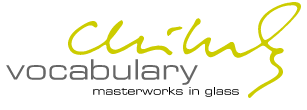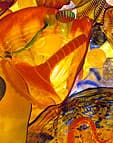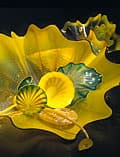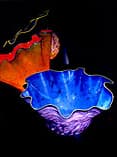
 Central
to an understanding of Chihuly's practice
is that since the 1960s, when he began to experiment with glass, he
has always worked in series. Equally important is the emphasis that
Chihuly places on teamwork - and his role within the group has been
most frequently compared to that of a conductor or a film director.
After a car accident in 1976, Chihuly lost the sight in one eye and,
therefore, his depth perception; and, when he dislocated his arm three
years later, he gave up his position as gaffer. Central
to an understanding of Chihuly's practice
is that since the 1960s, when he began to experiment with glass, he
has always worked in series. Equally important is the emphasis that
Chihuly places on teamwork - and his role within the group has been
most frequently compared to that of a conductor or a film director.
After a car accident in 1976, Chihuly lost the sight in one eye and,
therefore, his depth perception; and, when he dislocated his arm three
years later, he gave up his position as gaffer. |
 |
|
Citron
green tower with red infusion 1998 (Detail) blown glass, 342.9 x
203.2 cm from Hiroshima City Museum of Contemporary Art, Japan Photograph:
Studio ASK
|
From early experiments with weaving and neon, Chihuly has produced a range of fluid forms and dramatic installations. Throughout the development of this vocabulary of forms - from the first Blanket cylinders and Baskets during the mid-1970s, through the Seaforms, Macchias, Persians and Venetians, to the Floats, Ikebanas and Chandeliers of the 1990s - Chihuly has developed a remarkable ability to draw to him artists of great skill. His working relationship with William Morris, for example, spanned eight years: it was to Morris that Chihuly first relinquished his position as gaffer and, from 1978, they cultivated the Seaforms and then the Macchia series.
CHIHULY: Masterworks in glass shows the way in which the Macchia and Persians are the building blocks of Chihuly's most recent extravaganzas. The Macchia (Italian: 'stain' or 'spot'), in turn, succeeded the subtle Seaforms when Chihuly decided to make use of all 300 colours available to him commercially. The latter forms - begun in 1986 with Martin Blank as gaffer - are the most frequently used: whether installed vertically or horizontally, as in the Persian wall or the Persian pergola in this exhibition, they make reference to oceans, sunsets and exotic travel.
 |
| Persian
pergola 1999 (Detail)
Installation, blown and sheet glass, Collection of the artist Photo: Brenton McGeachie |
 |
| Brilliant yellow and green persian set with onyx and yellow lip wraps 1997 blown glass, Collection of the artist Photo: Brenton McGeachie |
 |
| Macchia forest 1999 Installation, (Detail) blown glass, Collection of the artist Photo: Brenton McGeachie |